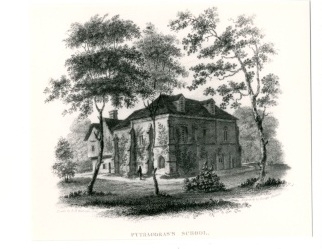From the beginning: The Stone House and the Dunning Family
The building now known as the School of Pythagoras was constructed during the twelfth century. From the Hundred Rolls, we can see that it first belonged to the Dunning family and that, at the time, it was called the Stone House. While it is difficult to settle on a precise date, it appears that a Eustace Dunning was certainly living in the Stone House with his wife and three children from the mid-twelfth century onwards, though they are likely to have owned the house before then.
The Dunnings were reasonably wealthy, and Eustace’s two sons inherited a large amount of property both in and around Cambridge after their father’s death. Hervey Dunning, who inherited the Stone House, became a major land-owner and a prominent figure in the civic life of Cambridge. When King John granted the burgesses of the town the right to a Gild Merchant in 1201, for instance, Hervey Dunning was selected as an early alderman, and went on to be elected as prepositus, or mayor, in 1207.
When Hervey died in around 1240, the Stone House once again passed to his son, the second Eustace Dunning. Yet in contrast to the prosperity and success of his father, Eustace Dunning seems to have held no civic responsibilities and suffered periods of severe financial hardship throughout his life, primarily in consequence to his dealings with a man named Magister Guy de Castro Bernardi.
Between 1257 and 1264, Eustace approved the terms for several loan agreements with Magister Guy, which he frequently struggled to meet. The first transaction between the two men, conducted in 1257, consisted of a six-year lease, by which Magister Guy agreed to pay Eustace an annual sum of fourteen marks for the rent of Eustace’s property in Cambridge, Girton and Chesterton. The Dunnings appear to have maintained possession of the Stone House during this time. Eustace’s financial situation did not improve, however, and in 1260, he formed a new agreement with Magister Guy, in the form of a charter and a bond, as the historian, John Gray, explains:
By the charter Eustace conveyed the whole of his property in Cambridge, Chesterton, and Girton to Master Guy. In the bond he undertook to repay Master Guy £100 at Michaelmas, 1260. The charter was handed to the Prior of the Friars Preachers in Cambridge for safe-keeping. If Eustace honoured his bond, the charter was to be returned to him; if he made default, it was to be handed to Master Guy. From a summary of the letter, which was once in the archives of Merton College, it would appear that Eustace Dunning only received £81.3s.4d. of the £100 he was bound to repay. When Michaelmas came, Eustace had not the money and applied to his creditor for further time. Master Guy did not at once foreclose. He obtained a further bond from Eustace. By the terms of this new bond Eustace was to repay £100 in the church of St Peter-next-the-Castle on the Sunday in 1261 when Quasi Modo was chanted. In default all the mortgaged lands were to go to Master Guy forever. The appointed Sunday came, but Eustace Dunning did not bring the money to St Peter’s Church. In 1263 he needed more money and again had recourse to Master Guy […]. After 1264 the loans ceased. Master Guy did not evict Eustace, but this forbearance was not from feelings of charity.[1]
Eager to make a profit by selling the messuage at a later date, Magister Guy permitted Eustace and his family to remain in the Stone House until property prices improved. Yet Magister Guy died before the sale of the Stone House could be realised, so that it was Master Guy’s nephew, William of Manfield, who finally succeeded in selling the Stone House and its adjacent land to Walter de Merton in 1270.
Evicting the Dunnings from the Stone House was another matter. By 1270, Eustace Dunning had also died and the building was occupied by Eustace’s son, Richard Dunning, who resisted all efforts for his removal. Having owned the Stone House for more than one hundred years, the Dunnings were not willing to have it taken away from them without a fight! It was only, in fact, a year later, on 6 October 1271, that Richard finally departed from the Stone House for the village of Gamlingay, to the south-west of Cambridge. The building was subsequently conveyed to the warden and scholars of the House of the Scholars of Merton, later Merton College, Oxford, who would only rightfully acquire the entirety of the mortgaged land in 1278, at a price of more than one hundred and eighty pounds.
